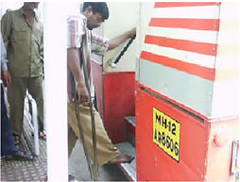Transport access and mobility for people with disabilities
Introduction
Encouraging greater access to transport, including public transport modes, can substantially transform the livelihoods of disabled people themselves and their immediate families. People with disabilities are specifically recognized as a vulnerable population, due to the double penalty of societal discrimination and physical exclusion, which often traps them in poverty (DFID, 2000).
Inaccessible transport can make it especially difficult for disabled people to find employment, to gain an education and access health care, as well as limit their social and recreational activities.
In addition, poverty ensures that disabled people are least likely to be able to afford to live in areas with easy access to social services. Thus, when the need arises disabled people should be able to travel locally or within urban and suburban areas using public transport and other modes with ease.
Sadly, however, in cities within developing and transition countries this is the exception rather than the rule. Improved mobility is a crucial and necessary element in alleviating poverty throughout the developing world as it can allow people with disabilities to play an active role in society both economically and socially.
Countries in the developed world have made significant progress in improving the accessibility of transport systems to people with disabilities, and adhere to standards that are generally uniform (albeit with local variations). Among developing countries the situation is much more diverse. Accommodation of the needs of people with disabilities is still largely seen as a welfare function of the state and of non-governmental welfare organizations.
The human rights approach to disability, in terms of which every citizen has the right to be included in social and economic opportunities, is however, slowly gaining acceptance. In some developing and transition countries awareness is growing of the need to gradually remove barriers in the transport environment.
The trend is strengthened when stakeholders realize that the same features that benefit people with physical, sensory and cognitive impairments also benefit other travelers. Slow progress is partly caused by funding constraints, but also by a lack of good practice and awareness which means that where features are included they are not always appropriate to the needs of travellers.
For example, in some countries kerb ramps have been installed to provide easy access to footpaths, yet many are non-functional due to steep slopes, or barriers such as garbage bins or street vendors who set up stalls and sell vegetables and fruits on the pavements.
When reviewing the progress made on accessibility a general development path emerges. Countries tend to follow a progression from general awareness of disability issues, to addressing limited aspects of mobility, to fuller incorporation of access issues in public transport.
This progression as is evident among transition and developing countries is similar in many respects to the process followed by North American and European countries over the last four decades, with the exception that rights-based approaches tend to feature increasingly early on in the process.
This paper is based on a three-year research programme undertaken in India, Malawi, Mozambique and South Africa by a consortium of researchers (funded by the UK Department for International Development (DFID).
Although basic problems faced by disabled travellers are similar world wide, access solutions cannot simply be transplanted from developed to developing countries as, clearly, priorities, resources, and operating conditions vary greatly. The research utilizes principles of universal design to improve access to the pedestrian and public transport systems for all users. Read more…..
